tow Oldsmobile Cutlass Supreme 1993 Owner's Manuals
[x] Cancel search | Manufacturer: OLDSMOBILE, Model Year: 1993, Model line: Cutlass Supreme, Model: Oldsmobile Cutlass Supreme 1993Pages: 340, PDF Size: 16.21 MB
Page 18 of 340
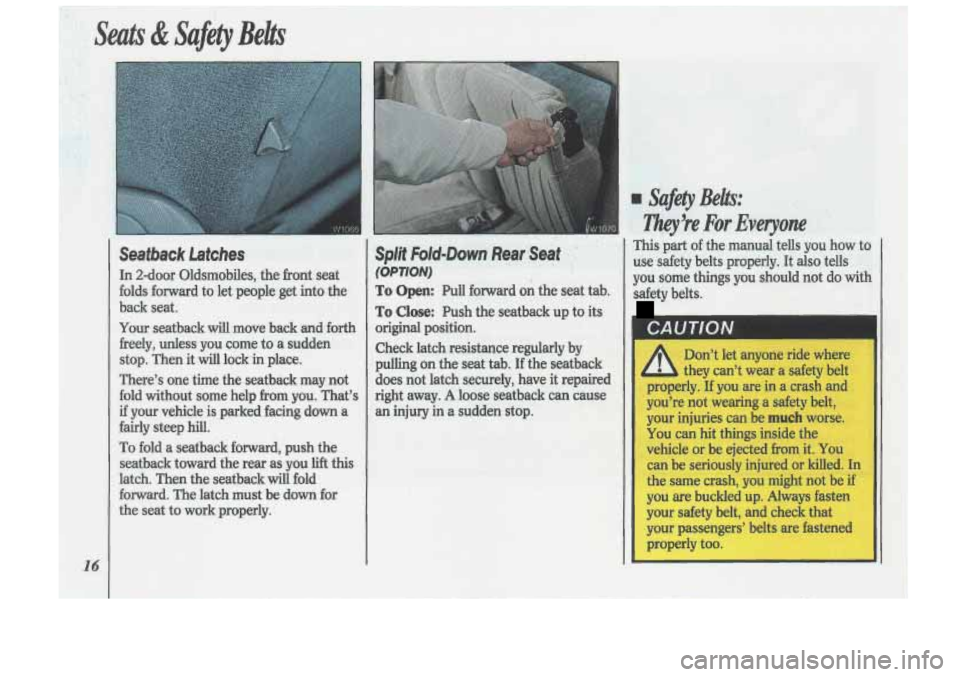
16
Seats & Safety Belts
Seatback Latches
In 2-door Oldsmobiles, the front seat
folds forward
to let people get into the
back seat.
Your seatback will move back and forth
freely, unless you come to a sudden
stop. Then it
will lock in place.
There’s one time the seatback may not
fold without some help from you. That’s
if your vehicle is parked facing down a
fairly steep hill.
To fold a seatback forward, push the
seatback toward the rear as you lift this
latch. Then the seatback will fold
forward. The latch must be
down for
the seat to work properly.
Split Fold-Down Rearmseat ’ ,”
(OPTION)
To Open: Pull forward on the seat tab.
To Close: Push the seatback up to its
original position.
Check latch resistance regularly by
pulling on the seat tab. If the seatback
does not latch securely, have it repaired
right away.
A loose seatback can cause
an injury in a sudden stop.
I Safety Belts:
Ziky!re For Everyone
This part of the manual tells you how to
use safety belts properly. It
also tells
you some things you should not do
with
safety belts.
CAUTION
Don’t let anyone ride where
they can’t wear a safety belt
properly.
If you are in a crash and
you’re not wearing
a safety belt,
your injuries can be
much worse.
You can hit things inside the
vehicle or be ejected
from it. You
can be seriously injured
or killed. In
the same crash, you might not be if
you are buckled up. Always fasten
your safety belt, and check that
your passengers’ belts are fastened
properly too.
Page 42 of 340

Seats & Safety Belts
40
Larger Children (CONT.)
Children who aren’t buckled up can
strike other people who are.
I CAUTION
I A Never do this.
Here two children are
wearing the same belt. The belt
I properly spread the impact
,,,ces. In a crash, the
two children
can be crushed together and
seriously injured.
A belt must be
used by
-y one son at a time.
Q: What if a child is wearing a lap-
shoulder belt, but the child is
so
small that the shoulder belt is very
close to the child’s face
or neck?
A: Move the child toward the center of
the vehicle, but be sure that the
shoulder belt still is on the child’s
shoulder,
so that in a crash the
child’s upper body would have the
restraint that belts provide.
If the child is
so small that the
shoulder belt is still very close to the
child’s face or neck, you might want
to place the child in the center seat
position, the one that has only a lap
belt.
Page 61 of 340

Park
P (Park): This loclcs your front
wheels. It’s the best position
to use
when you start your engine because
your vehicle can’t move easily.
A
I It is dangerous to get out of your vehicle if the shift lever is not fully in
P (Park) with the parking brake firmly set. Your vehicle can roll.
Don’t leave your vehicle when the engine
is running unless you have to. If you
have left the engine running, the vehicle can move suddenly. You or others
could be injured.
To be sure your vehicle won’t move, when you’re on fairly
level ground, always set your parking brake and move the shift lever to
P (Park).
See the
Index under Shifting Into P (Park). If you are parking on a hill, or if
you’re pulling a trailer, also see the
Index under Parking on Hills or Towing a I
Trailer. I
59
Page 62 of 340
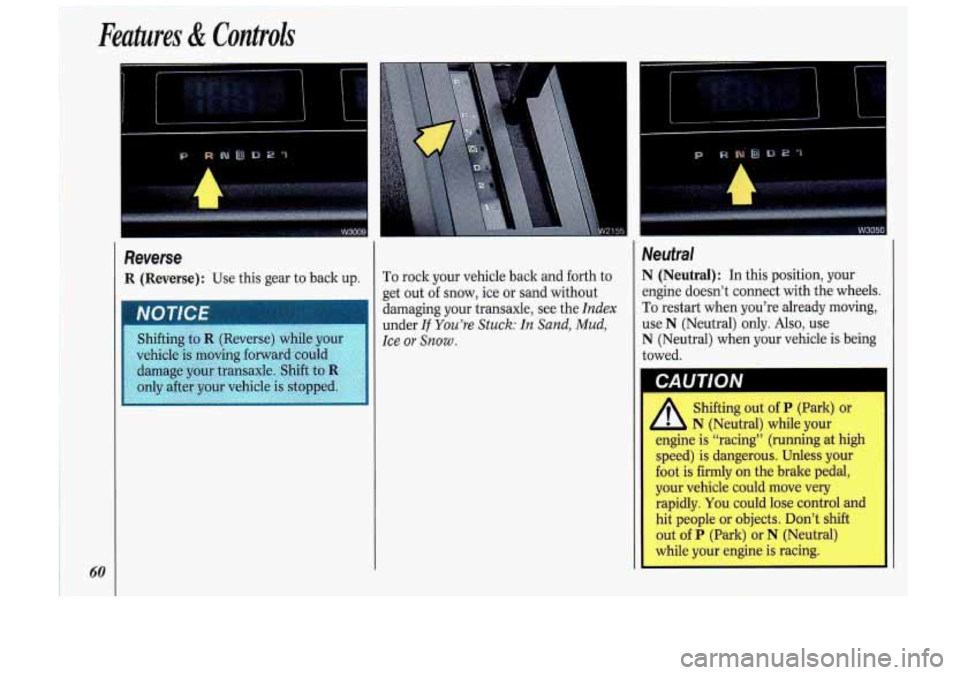
Features & Controls
1
Reverse
R (Reverse): Use this gear to back up. To rock your vehicle back and forth to
get out
of snow, ice or sand without
damaging your transaxle,
see the Index
under If You’re Stuck: In Sand, Mud,
Ice or Snow .
CY
Neutral
N (Neutral): In this position, your
engine doesn’t connect with the wheels.
To restart when you’re already moving,
use N (Neutral) only. Also, use
N (Neutral) when your vehicle is being
towed.
A
Shifting out of P (Park) or
N (Neutral) while your
engine is “racing” (running at high
speed) is dangerous. Unless your
foot is firmly on the brake pedal,
your vehicle could move very
rapidly.
You could lose control and
hit people
or objects. Don’t shift
out of
P (Park) or N (Neutral)
lwhile your engine
is racing.
Page 64 of 340
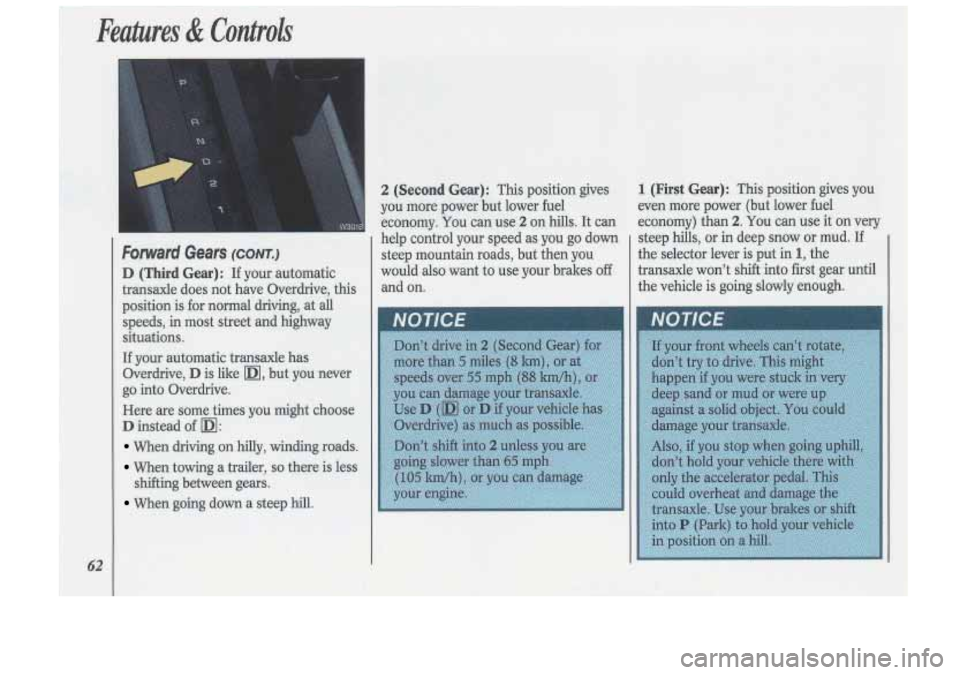
Features & ControIs
62
Forward Gears (CONT.)
D (Third Gear): If your automatic
transaxle does not have Overdrive, this
position is for normal driving, at all
speeds, in most street and highway
situations.
If your automatic transaxle has
Overdrive,
D is like m, but you never
go into Overdrive.
Here are some times you might choose
D instead of m:
When driving on hilly, winding roads.
When towing a trailer, so there is less
When going down a steep hill.
shifting between gears.
2 (Second Gear): This
position gives
you more power but lower fuel
economy.
You can use 2 on hills. It can
help control your speed as you go down
steep mountain roads, but then you
would also want to use your brakes
off
and on.
1 (First Gear): This position gives you
even more power (but lower fuel
economy) than
2. You can use it on very
steep hills, or in deep snow or mud.
If
the selector lever is put in 1, the
transaxle won’t shift into first gear until
the vehicle
is going slowly enough.
Page 65 of 340
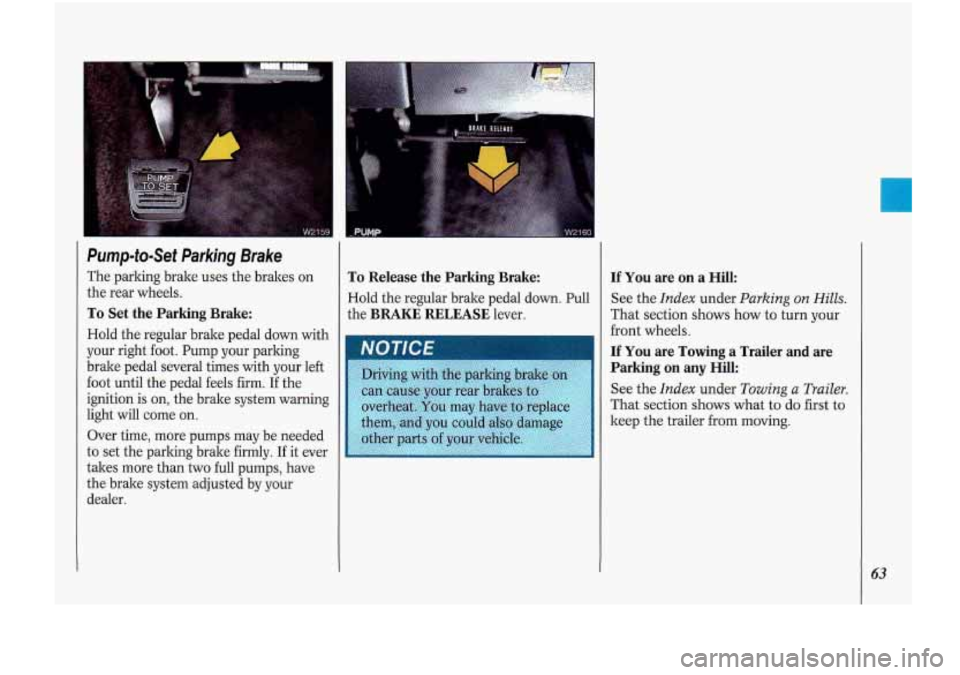
Pump-to-Set Parking Brake
The parking brake uses the brakes on
the rear wheels.
To Set the Parking Brake:
Hold the regular bralte pedal down with
your right foot. Pump your parking
brake pedal several times with your left
foot until the pedal feels firm. If the
ignition is
on, the brake system warning
light will come on.
Over time, more pumps may be needed
to set the parlung brake firmly. If it ever
takes more than two full pumps, have
the brake system adjusted by your
dealer.
..
To Release the Parking Brake:
Hold the regular brake pedal down. Pull
the
BRAKE RELEASE lever.
If You are on a Hill:
See the Index under Parking on Hills.
That section shows how to turn your
front wheels.
If You are Towing a Trailer and are
Parking on any Hill:
See the Index under Towing a Trailer.
That section shows what to do first to
keep the trailer from moving.
63
Page 66 of 340
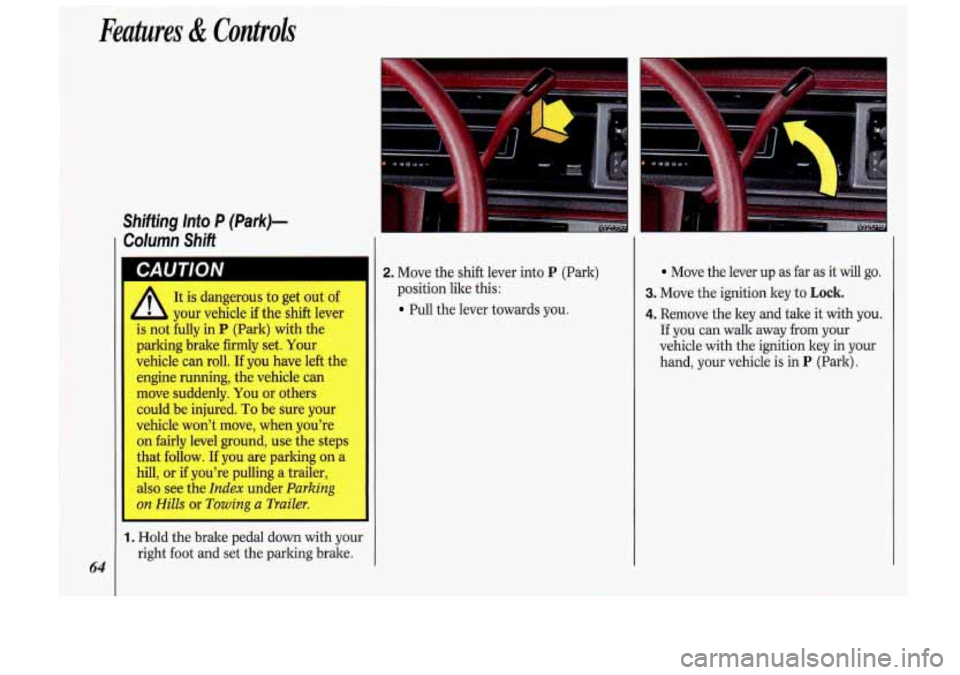
Features & Controli
64
Shifting lnto P (Park)-
Column Shift
It is dangerous to get out of
your vehicle if the shift lever
is not fully in
P (Park) with the
parking brake firmly set. Your
vehicle can roll. If you have left the
engine running, the vehicle can
move suddenly.
You or others
could be injured.
To be sure your
vehicle won't move, when you're
on fairly level ground, use the steps
that follow.
If you are parking on a
hill, or if you're pulling a trailer,
also see the
Index under Parking
on Hills or Towing a Trailer.
1. Hold the brake pedal down with your
right foot and set the parking brake.
'." ' I
2. Move the shift lever into P (Park)
position like this:
Pull the lever towards you.
Move the lever up as far as it will go.
3. Move the ignition key to Lock.
4. Remove the key and tale it with you.
If you can walk away from your
vehicle with the ignition key in your
hand, your vehicle
is in P (Park).
Page 67 of 340

Shjfthg ‘Into P (Park)-
Console
Shift
A
It is dangerous to get out of
your vehicle
if the shift lever
is not fully
in P (Park) with the
parking brake firmly set. Your
vehicle can roll. If you have left the
engine running, the vehicle can
move suddenly. You or others
could be injured.
To be sure your
vehicle won’t move, when you’re
on fairly level ground, use the steps
that follow. If you are parking
on a
hill, or
if you’re pulling a trailer,
also see the
Index under Parking
on Hills or Towing a Trailer.
1. Hold the brake pedal down with your
right foot
and set the parking brake.
2. Move the shift lever into the P (Park)
position like this-:.
Hold in the button on the lever,
and push the lever
all the way
toward the front of your vehicle.
3. Move the ignition key to Lock.
4. Remove the key and take it with you.
If you can wallc away from your
vehicle with the ignition key
in your
hand, your vehicle is in
P (Park).
Leaving Yo,ur Vehicle Wfih the
Engine Running
I
Page 69 of 340
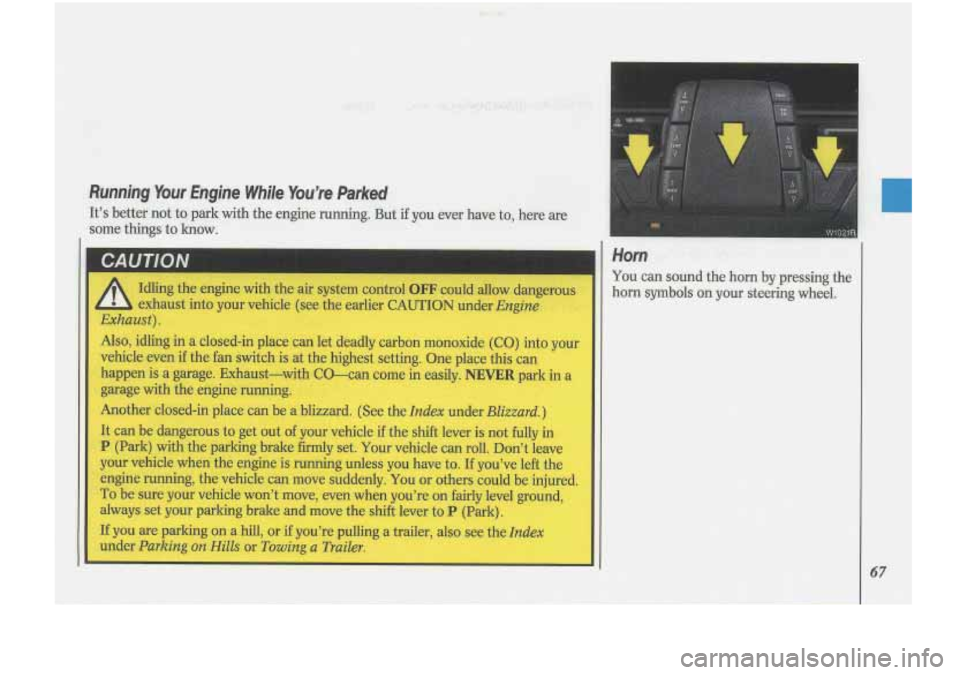
CAUTION --
A
Idling the engine with the air system control OFF could allow dangerous
exhaust into your vehicle (see the earlier CAUTION under
Engine
Zxhaust).
Also, idling in a closed-in place can let deadly carbon monoxide (GO) into your
vehicle even if the fan switch is at the highest setting. One place this can
happen is a garage. Exhaust-with CO-can come in easily.
NEVER park in a
garage with the engine running.
Another closed-in place can be a blizzard. (See the
Index under Blizzard.)
It can be dangerous to get out of your vehicle if the shift lever is not fully in
P (Park) with the parking brake firmly set. Your vehicle can roll. Don't leave
your vehicle when the engine is running unless you have to. If you've left the
engine running, the vehicle can move suddenly. You or others could be injured.
To be sure your vehicle won't move, even when you're on fairly level ground,
always set your parking brake and move the shift lever to
P (Park).
If you are parking on a hill, or if you're pulling
a trailer, also see the Index
under Parking on Hills or Towing a Trailer.
Page 80 of 340

Features & Controls
78
Daytime Running Lights (CONK)
At dusk, the exterior lights will come on
automatically and the low beams will
change to full brightness. At dawn, the
exterior lights will go out and the low
beams will change to the reduced
brightness of
DRL (if the headlight
switch is off).
Of course, you may still turn on the
headlights any time you need to.
To idle your vehicle with the DRL off,
set the parking brake while the ignition
is in the
Off or Lock position. Then
start the vehicle. The DRL will stay off
until you release the parking brake.
Headlight High-Low Beam
Changer
To change the headlights from low
beam to high or high to low, pull the
turn signal/headlight beam lever all the
way toward you. Then release it.
When the high beams are on,
a blue
light on the instrument panel also will
be on.
Flash-to- Pass
Flash-to-pass lets you use your high
beam headlights
to signal a driver in
front of you that you want to pass.
To use it, pull the turn signal/headlight
beam lever toward you.
If Your Headlights are Off
Your high beam headlights will turn on.
They'll stay on
as long as you hold the
lever there. Release the lever to turn
them off.
If Your Headlights are On:
No flash-to-pass. Use the lever to
change between high and low beams, as
explained under
Headlight High-Low
Beam Changer
earlier in this section.
If You Have Fog Lights:
They go off whenever the high beams
are on. When the high beams go
off, the
fog lights will come on again, if the fog
light switch is on.